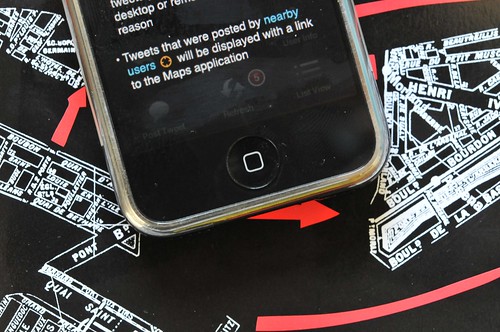Architecture is the simplest means of articulating time and space, of modulating reality and engendering dreams…The architecture of tomorrow will be a means of modifying present conceptions of time and space. It will be both a means of knowledge and a means of action. Architectural complexes will be modifiable. Their appearance will change totally or partially in accordance with the will of their inhabitants.
Formulary for a New Urbanism, Ivan Chtcheglov, 1953, from Situationist International Anthology, Ken Knabb editor.
I’m no theorist of space, architecture, and digital media — there are plenty of bright ones about. What I’m curious about are the material choices available to the design and construction of spaces that are modifiable by their inhabitants. What are the ways that time and space — the key elements for bounding and warping habitats — will be “architected” by the time and location-based activities of digital devices?
"Locative Media" is the term that was (once) used to describe media that is digitally marked with some location correlation. In the most primordial example, a photograph is inscribed with the location from where it was taken. Now, we see these sorts of weak-signals leaking into all kinds of (somewhat anticipated, eagerly accepted) “tagging” of many new and curious forms of digital-social expression. What does it mean to find out that someone is Twittering near me? How does this turn into new “architectural” forms? How do constructed spaces — buildings, walkways, obstacles, protected spaces — shift and re-orient and deconstruct when large-scale locative experiences occur within them? How do manufactured times — work-time, after-hours, dead-time — shift and bias and become occupied and “spent” in new unexpected ways?
The weak-signals of such things were the playful social experiences of early pioneers. Location-specific social networks like Dodgeball, Platial, Plazes — and on, and on — were all working from the well-founded hunch that social practices beyond the trinity of the screen-keyboard-mouse will likely be about the production of a new kind of space, one that is a hybrid of the digital and geographical (if we just start with the “instrumentalized” keystones, the things absent discussion about the social practices that give things meaning.)
These new unexpected, re-mappings of space/time and social networks (I have mine who are nearby, who accidentally come “in range”, who are in entirely different geographies and time-zones) could be an interesting basis for Alison Sant’s notion of the redefined basemap.
Why do I blog this? I’m curious to see how platforms that are aware of location and that support direct participation in the creation of (relatively sophisticated) “apps” (bleech..) and that are somewhat moved away from the fixed, immovable desktop trinity of screen-keyboard-mouse can create new kinds of mechanisms for maintaining and knitting together networks of social relations and the creation of new kinds of knowledge and culture.
